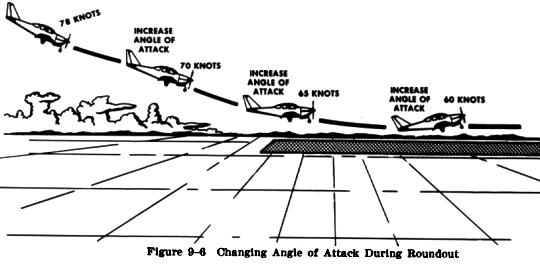
The roundout is a slow, smooth transition from a normal approach attitude to a landing attitude. When the airplane, in a normal descent, approaches within what appears to be about 10 to 20 feet above the ground, the roundout or flare should be started, and once started should be a continuous process until the airplane touches down on the ground.
As the airplane reaches a height above the ground where a timely change can be made into the proper landing attitude, back elevator pressure should be gradually applied to slowly increase the pitch attitude and angle of attack. This will cause the airplane's nose to gradually rise toward the desired landing attitude. The angle of attack should be increased at a rate that will allow the airplane to continue settling slowly as forward speed decreases.
When the angle of attack is increased, the lift is momentarily increased, thereby decreasing the rate of descent (Fig. 9-6). Since power normally is reduced to idle during the roundout, the airspeed will also gradually decrease. This, in turn, causes lift to decrease again; it must be controlled by raising the nose and further increasing the angle of attack. During the roundout, then, the airspeed is being decreased to touchdown speed while the lift is being controlled so the airplane will settle gently onto the landing surface. The roundout should be executed at a rate that the proper landing attitude and the proper touchdown airspeed are attained simultaneously just as the wheels contact the landing surface.

The rate at which the roundout is executed depends on the airplane's height above the ground, the rate of descent, and the pitch attitude. A roundout started excessively high must be executed more slowly than one from a lower height to allow the airplane to descend to the ground while the proper landing attitude is being established. The rate of rounding out must also be proportionate to the rate of closure with the ground; that is, when the airplane appears to be descending very slowly, the increase in pitch attitude must be made at a correspondingly slow rate.
The pitch attitude of the airplane in a full flap approach is considerably lower than in a no flap approach. Therefore, to attain the proper landing attitude before touching down, the nose must travel through a greater pitch change when flaps are fully extended. Since the roundout is usually started at approximately the same height above the ground regardless of the degree of flaps used, the pitch attitude must be increased at a faster rate when full flaps are used. However, the roundout should still be executed at a rate proportionate to the airplane's downward motion.
Once the actual process of rounding out is started, the elevator control should not be pushed forward. If too much back pressure has been exerted, this pressure should be either slightly relaxed or held constant, depending on the degree of the error. In some cases, it may be necessary to advance the throttle slightly to prevent an excessive rate of sink, or a stall, all of which would result in a hard drop in landing.
It is recommended, therefore, that the pilot form the habit
of keeping one hand on the throttle throughout the approach and landing,
should a sudden and unexpected hazardous situation require an immediate
application of power.
Well before starting the roundout, it is imperative that
the pilot recheck the landing gear for the "down and locked" indications,
and place the propeller control in high RPM position, if the airplane is
so equipped.